|
Jupiter in 2012/13: Interim report no.9 (2013 Jan.):
January 21, 2013 |
|
Japanese (translated by Yuichi Iga)
Summary This report covers Jupiter from 2012 Aug. to Dec., and follows on from our previous reports nos.3 and 6 [refs.1 & 2]. During this period, the planet’s appearance has become more normal after the drama of the NEB and NTB Revivals, but there is still much complex activity in those regions, and reddish colour is still widespread across the NTB(S), NEB, and parts of EZ. The NNTB is still absent but we are able to trace the long-lived ovals in the NNTZ, whose recent history is summarised in Appendix 1. The conjunction of the increasingly red GRS with the very red oval BA has also produced a striking appearance. Along with this report are six Appendices giving further details:
Appendix 1: NNTZ: Anticyclonic ovals, 2008-2012 (Gianluigi Adamoli & John Rogers)
Methods Thanks are due to all the observers, who have produced a huge number of excellent images throughout the apparition, often in spite of difficult weather conditions. Unfortunately, space prevents us from showing relevant images from all observers - sometimes several hi-res image sets are produced at the same time - but all are appreciated. Thanks too to those who have commented on various interesting phenomena during the apparition, especially Chris Go, Christophe Pellier, Manos Kardasis, Gianluigi Adamoli, and Michel Jacquesson. Much of the activity this apparition - such as the ongoing turmoil in the NEB, and the subtly shifting streaks and shadings in the EZ - would be best appreciated if the images could be compiled into hi-res map animations. However, this would require a great deal of careful work, made difficult by the varying resolution and colour balance of the different images, and by the distribution of observers in longitude which means that a given region is commonly imaged well on three successive rotations but not on the next two. Grischa Hahn has produced zonal wind profiles from sets of images in Sep., Nov., and Dec., as shown in Appendix 5. All the jets are well defined, even those which carry no visible spots at present. In general, these are all very similar to previous profiles from spacecraft, confirming that the NEB and NTB Revivals have not altered the zonal wind profiles. As usual, all images and maps are presented with south up. Speeds of spots are measured from the JUPOS charts and quoted as DL2 (degrees of System II longitude per 30 days), unless otherwise specified. All JUPOS charts show bright spots as red and dark spots as black. Overall appearance There have been progressive colour changes over the months (Fig.1). The GRS, NEB, and oval BA, have all darkened and reddened. Much of the NEB seems to have become darker and redder as the turbulence of the Revival subsided, at least in regions which are not affected by new rifts; but its northern edge is grey and becoming lighter. In contrast the NTB(S), dark and strongly orange in August after the Revival, is gradually fading. The major zones on the planet also have rather different colours. The NTropZ is still very narrow, but its early ochre shading has brightened to white. The EZ has a broad ochre EB at some longitudes, though this too has become paler since the summer. The NTZ-NNTZ comprise a single broad white zone, the NNTB being absent. And the STropZ-STZ, at many longitude where the STB is tenuous, also comprise a broad white zone - but bluer than other zones, and indeed, distinctly blue in some images in Nov-Dec. As we do not have an absolute standard of colour on Jupiter, it is possible that the STropZ-STZ is truly white, and all other zones, including the NTZ-NNTZ, are reddish to some extent. Selected images in methane-band and ultraviolet filters can be seen in Figs.4, 10 &.12, and some other methane-band images are in the Appendices.
A complete map in the methane band, with a report, has been posted by Manos Kardasis at: N.N.Temperate Region The NNTB, and the NNTBs jetstream spots, were wiped out during the NTB outbreak, and they are still absent; the whole N.N.Temp. region appears merged with the NTZ in a single broad white zone. Only faint minor streaks, and a few small faint jetstream spots, have been detected in the NNTB latitudes, and they have been transient. One spot however is distinct: NN-LRS-1, the often-reddish anticyclonic oval which has existed at least since 1993 [ref.3]. This apparition it has strong red colour and a notably dark rim. It appeared similar while the NNTB was temporarily whitened in 2009, just as the GRS tends to become darker and redder when the SEB is whitened. A second Little Red Spot has also been detected in the NNTZ, mainly because it is bright in methane images. As we do not know whether it will persist for long, we give it a temporary designation of ‘LRS-b’. In visible light it is very small and often almost invisible, but in favourable images, it appears a luminous pale pink colour. The colour seems to be sensitive to the filters or channels used, as it can hardly be seen at all in some observers’ hi-res images. G. Adamoli and C. Pellier have tracked this back as a tiny white spot in summer, 2012, and probably earlier. See Appendix 1 for the history, JUPOS chart, and image gallery of this and other anticyclonic ovals in the NNTZ. (Apart from LRS-1 and LRS-b, there are two other weakly methane-bright spots in this latitude, which are small white ovals tracked from previous apparitions.) N. Temperate Region The revived NTB is still a broad dark double belt. The S component is featureless, strongly reddish, and gradually fading. The N component is dark grey and notably wavy, as it was in 2008 after the previous NTB outbreak. The two components are separated by a narrow strip which, at the highest resolution, consists of innumerable tiny white spots. These are particularly evident in one sector where they comprise a turbulent rift opening through the NTBn edge [Fig.4] - sometimes generating miniature outbreaks (e.g. as noted by Chris Go on Sep.15). The drifts of features on NTBn, according to the JUPOS data, are quite diverse but all within the normal range of the N. Temperate Current (Fig.5). The rift has DL2 ~ +16 deg/month; so do several features p. it, including an unusually bright white oval in NTZ (which is also bright in methane images). Further p., most features have DL2 ~ +22 (+/-3) deg/month; while f. the rift, where the waviness is most pronounced, most features have DL2 = +30 deg/month. However, tracks with different speeds are interspersed, as in 2008-2009 [refs.4 & 5], and more study would be needed to determine the dynamics of these patterns. (Grischa Hahn’s zonal wind profiles show a well-defined gradient across the NTB latitudes; see Appendix 5.) One spot f. the rift moved with the NTBn jet at DL2 = +69 deg/month, so it is likely that the rift is disturbing this retrograding jet. Given what we observed in 2008-2009 [refs.4 & 5], it would not be surprising if within the next year or so, these phenomena were to develop into a N.Temperate Disturbance spanning the NTZ. The NTB(S) is orange and featureless and gradually fading. It is only methane-bright on its S edge [see Fig.10]. N. Tropical Region As the turbulence of the NTB and NEB Revivals has subsided, the NEB and NTropZ have gradually reverted to a more normal appearance [Figs.1 & 3]. Much of the NEB seems to have become darker and redder, at least in regions which are not affected by new rifts; but its northern edge is grey and becoming lighter, as the broadened belt starts to recede southwards again. Also the NTropZ, formerly veiled in pale ochre shading, has become lighter and is now white. However the present state cannot be called quiescence, because the rift activity in the NEB has developed impressively since it started in late August, and the developing barges and ovals in the NEBn are still unstable with several mergers and other interactions observed. These barges and ovals are charted in Fig.6. This extends the chart in our earlier report [ref.1], which showed the origin of 3 AWOs (red points), which have undergone successive mergers to form white spot A (now DL2 = -22 deg/mth) as well as the long-lived white spot Z (DL2 = -42 in Oct-Nov., probably faster than ever before, and DL2 = -38 in Nov-Dec.). The chart indicates that as many as 10 small dark brown barges have also developed, but several have undergone mergers or been disrupted by rifts, leaving only about 4 now. Appendix 2 (Figs.N1 to N5) presents detailed alignments of images in five longitude sectors, to show these interactions of spots in the NEBn. Well-observed mergers of a pair of AWOs and of a pair of barges show the same characteristics as similar mergers which we have observed in this latitude in previous years. Mergers of barges are quite common; we reported three examples in a paper in Icarus (2006) [ref.6], and have observed at least 6 examples since then[see refs. in Appendix 2]. Mergers of AWOs were not clearly observed until 2006, but we have recorded 6 since then, some in detail [Appendix 2]. Unlike mergers of AWOs in other latitudes [ref.6], those on NEBn usually appear to be incomplete, with a white cloud or fragment of one oval emerging Sf. the other with slower drift, although it usually disappears soon after. Meanwhile, the NEB north edge is already becoming lighter and disrupted; long sectors have become pale grey and there are ligher patches intruding onto it. So the expansion following the Revival already appears to be receding, suggesting that another cycle of narrowing and Revival could follow within a 3-year period.
NEB rifts Equatorial Region
NEBs dark projections
Equatorial Zone
SEBn: A new SED? S. Tropical region The SEB shows the usual vigorous rifting (bright convective disturbances) f. the GRS. There are two conspicuous spots in mid-SEB: a very dark barge and an irregular light spot (Figs.2 & 3). They were respectively at L2 = 83 and 107 on Aug.1, and L2 = 124 and 137 on Dec.10. The light spot has been mysterious; it is quite large, cream-coloured, stable (it has existed since 2011 July), but lacks the usual oval form of a circulation. However, an oval outline within it can be seen in v-hi-res images by HST on Sep.20 [ref.10], and by the Thai National Obs. on Dec.28 (S. Poshyachinda, TNO & NARIT) (thanks to Chris Go for forwarding both these images). This indicates that it is indeed a cyclonic circulation, similar to the dark barge, but filled with bright cloud, which also extends irregularly on the north side. The barge and the light spot have been converging intermittently. They have been just 13 deg. apart (centre to centre) throughout Dec. Any closer interaction would be interesting to watch. The SEBs edge proper, at 19-20 deg.S, is not greatly disturbed, and only two spots have been tracked in the retrograding jetstream: one with DL2 = +159 in Sep. (possibly the fastest retrograding speed ever recorded), and one with DL2 = +120 deg/mth in Dec. However, zonal wind profiles (see below) indicate that the jetstream is still present, just not marked by distinct spots.
Immediately to the S, at 22 deg.S, grey streaks form an extra band (‘SEB(SS)’?) at all longitudes. The JUPOS chart shows a wide range of speeds for these grey streaks, ranging from DL2 = 0 to +54 deg/mth, but mostly clustering around +10 to +18 deg/mth. The GRS (Figs.1 & 12) is at L2 = 187 on Dec.1, with DL2 = +1.2 deg/mth maintained since mid-2011, and the 90-day oscillation is clearly shown in the JUPOS chart as usual. It appears to have gradually become darker and redder during the apparition, after being very pale at the start. There were tenuous dark streaks around its S side in Aug-Sep., but these had disappeared by Dec. leaving the GRS as an isolated orange oval. S. Temperate region As usual, the STB is no more than a very tenuous STB(N) at most longitudes, but it has several sectors with substantial features (Figs.2, 11, 12). These are as follows. 1) Oval BA (Fig.12). This had regained quite strong orange colour at the start of the apparition, which has intensified even further since then; it is now as strongly red as anything gets on Jupiter, even more so than the GRS. Christophe Pellier and Damian Peach report (in 2013 Jan.) that the orange colour is easily seen visually at the eyepiece, even with 10 inches aperture. As always, the colour is in an annulus with a pale core. Oval BA passed the GRS on Sep.17. It had DL2 = -12 deg/mth before then, and -10 deg/mth after. 2) F. oval BA there is an unusual pair of quite stable cyclonic ovals (Fig.12). The first, on the f. edge of oval BA, is a small, extremely dark spot with a white collar. (Observers have noted its darkness weakening in recent weeks.) The second, 13 deg. f. the dark spot in Sep-Oct. but only 10 deg. f. in Nov-Dec after it passed the GRS, is a white oval, bordered by variable faint blue-grey streaks. Both must be cyclonic as they are at lower latitude than BA, and methane-dark (Fig.12). Surprisingly, the white space of STZ between them is not an anticyclonic oval (not distinctly methane-bright), although there is usually a small AWO in this position.
3) The only broad dark segment of STB is 60 deg. long and, with DL2 = -18 deg/mth, is rapidly converging on the cluster of ovals f. oval BA. Like many such STB segments (e.g. in the Cassini movies), it appears to be a turbulent cyclonic sector which emits small dark spots p. on the STB(N) (DL2 = -48 deg/mth for the best-defined one; they do not last beyond ~ 10-20 deg), and f. on the STB(S) (DL2 ~ 0 to +21 deg/mth; after tens of degrees, they end up in a southerly dark streak). Its p. end is now very close to the cyclonic white oval, so interaction could start at any time. Last time such an interaction happened, in 2010, it produced a remarkable outbreak of activity [ref.7]. 4) A small dark spot which had appeared in 2011 August, and was remarkably dark in 2012 July and August, with DL2 = -16 deg/mth. It gradually faded from Aug. to Oct., and by late Nov. it had turned into a tiny, light pink spot, embedded in a faint grey oblique streak. Although it is now very faint, this may be the new cyclonic disturbance that will come to dominate this sector of the STB. S.S. Temperate region There are 9 stable AWOs at 40-41 deg.S, labelled in Figs.2 & 3 and Fig.13 [JUPOS chart]. Because this population has been traced continuously over many years while some appeared and disappeared, they are labelled A0 to A9 with no A2. The SSTB is replaced by a cyclonic white strip between A1 and A3. Further S, the long-lived AWOs at ~50 deg.S and ~60 deg.S are still well tracked. They have variable speeds. The oval at ~60 S was virtually stationary at L2 = 95 from early Sep. to late Dec, while the oval at ~50 S halted due N of it from Oct.27 to Nov.8, although it rapidly prograded before and after.
|
|
References [--to our previous reports, including interim reports on the BAA Jupiter Section web site, numbered]
1. [2012 No.3]. Progress of Jupiter's great northern upheaval, 2012 July-August.
|
|
Figures
 Click for the original size
 Click for the original size
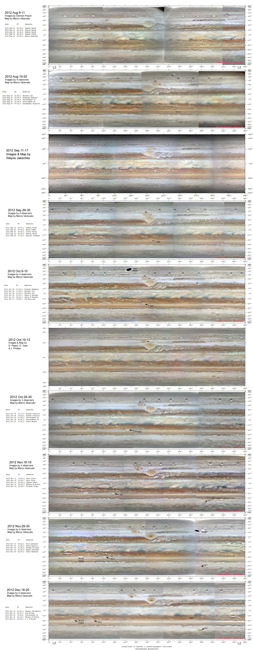 Click for the original size
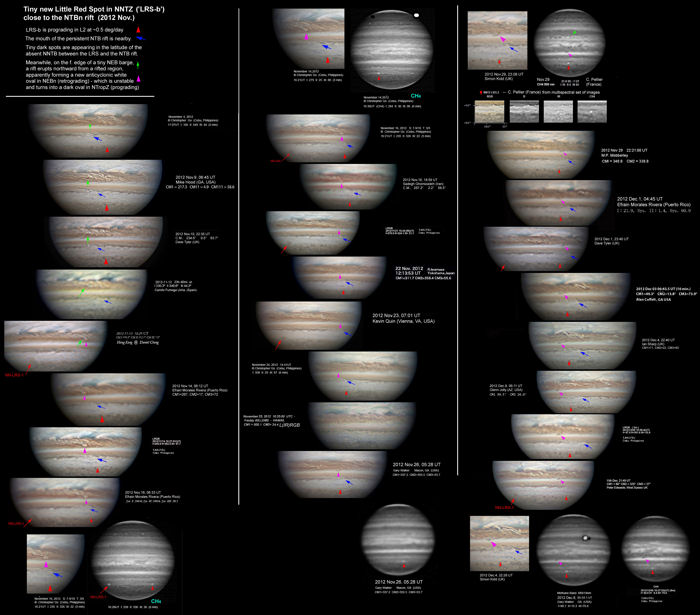 Click for the original size
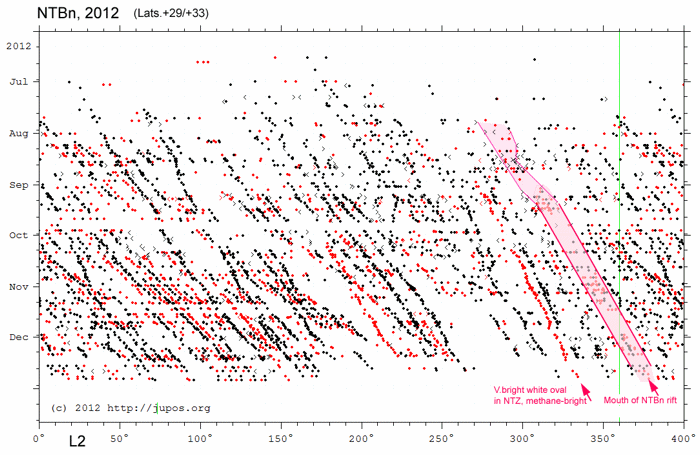 Click for the original size
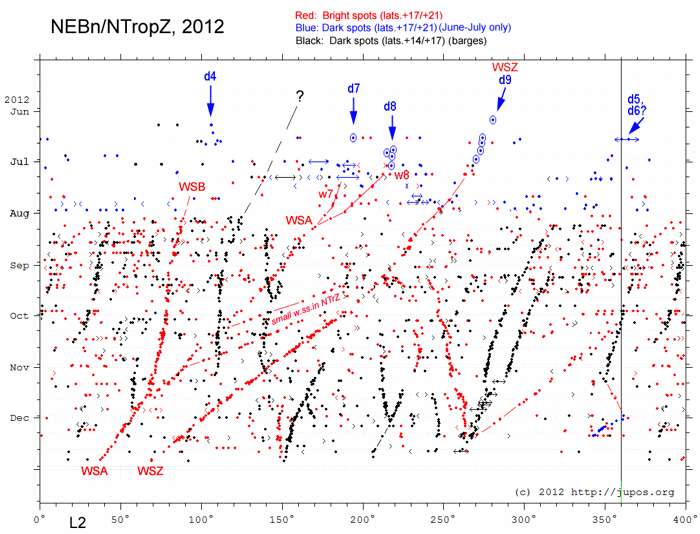 Click for the original size
 Click for the original size
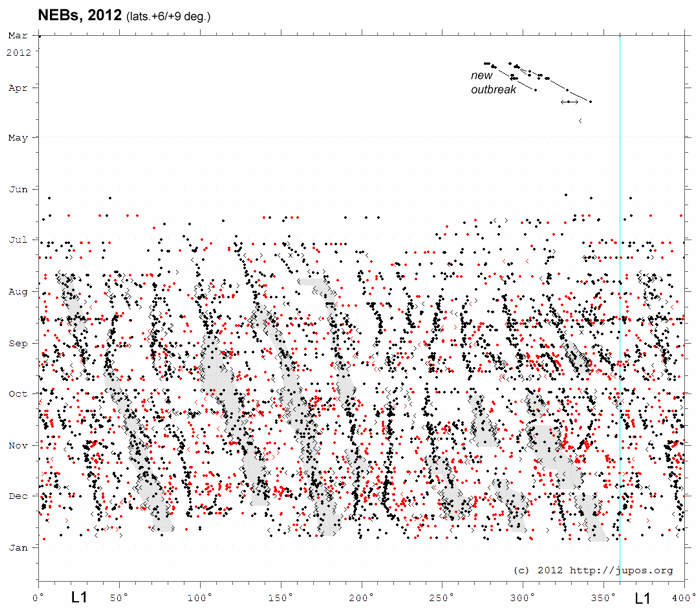 Click for the original size
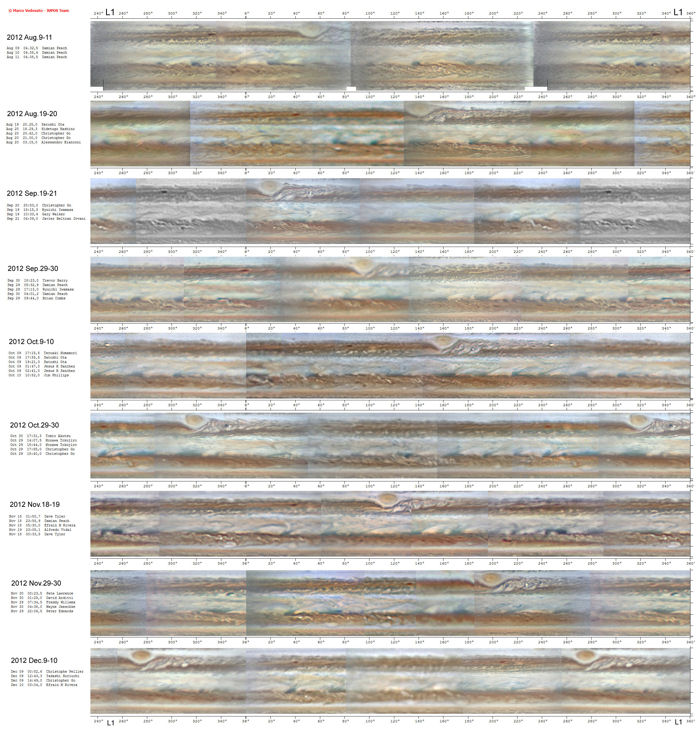 Click for the original size
 Click for the original size
 Click for the original size
 Click for the original size
 Click for the original size
|
|
John Rogers (British Astronomical Association), 2013 Jan.
|
|
Jupiter in 2012/13: Interim report no.9
Interim report on Jupiter, 2012 Aug.-Dec.
January 21, 2013 |
|
参考文献 []内はBAA木星セクションのwebサイトの中間レポートを含めた以前のレポートへの番号を示す。
1. [2012 No.3]. Progress of Jupiter's great northern upheaval, 2012 July-August.
|
|
図
 Click for the original size
 Click for the original size
 Click for the original size
 Click for the original size
 Click for the original size
 Click for the original size
 Click for the original size
 Click for the original size
 Click for the original size
 Click for the original size
 Click for the original size
 Click for the original size
 Click for the original size
|
|
John Rogers (British Astronomical Association), 2013 Jan. 【日本語訳:伊賀祐一 (Yuichi Iga)】 |